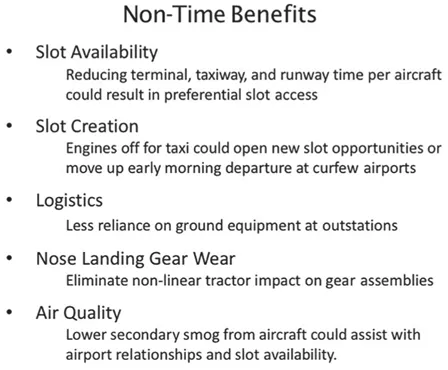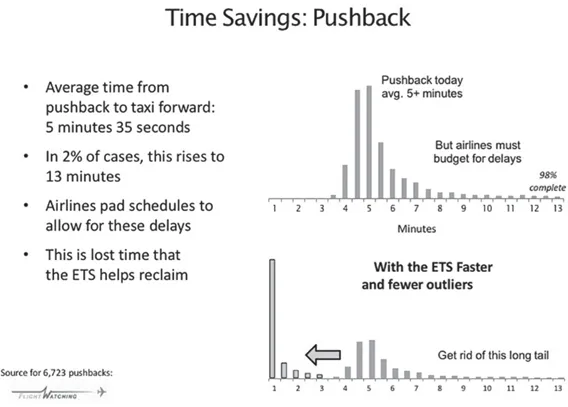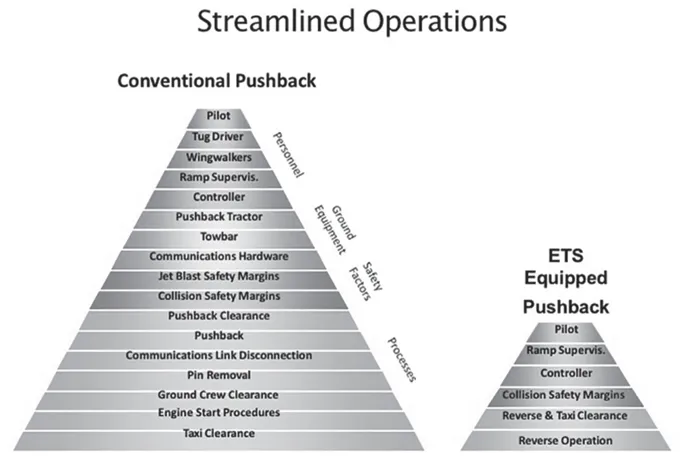![]()
CHAPTER 1:
Introduction
Commercial airplanes are getting more expensive to operate for several reasons, including the costs for airport expansions, rising wages of airline employees, and the cost of jet fuel, which are all passed on to the airlines and then to paying customers. In fact, research reveals that jet fuel is 40% – 60% of an airline’s operating cost. In order to keep air travel affordable, the airline industry must focus on reducing the costs of aircraft operation. Since everyone flies the same aircraft at the same speed, airlines can distinguish themselves by improving efficiency on the ground. Reconsidering taxiing will improve efficiency in fuel consumption, airport facility access, and improved ground handling operations.
Aircraft use thrust from their main engines for all ground movements on the tarmac. A reduction in airline operational costs could be accomplished in part through new ways to taxi the aircraft. The thrust from the aircraft gas turbine engines for taxiing operates less efficiently than at cruise because they are designed to operate at higher thrust settings. Engine thrust taxiing is inefficient and contributes to high fuel costs, additional engine maintenance, and poor airport area air quality. Some airlines have implemented single engine taxiing to reduce fuel costs and emissions. However, the single engine taxi is subject to greater thrust settings during ground movements and needs more attention from the individual airline operations managers.
This operational inefficiency is not a problem for the Aircraft Electric Taxi System (ETS) which is comprised of motors installed inside the aircraft wheels that propel the aircraft during taxiing and use only electrical power.
Using electric power from a battery and/or a small auxiliary power unit (APU) located in the tail of the aircraft to drive the electric motors would reduce the fuel consumption of the main engines. Additionally, revisiting the way that aircraft taxi may decrease the congestion of aircraft between terminal gates and runways in commercial airport environments.
There is likely to be initial pushback against the electric taxi from airlines since (a) this new mechanism is seen as a major revolution in aircraft ground handling operations; (b) additional training will be required to operate the aircraft under electrical power; (c) the increased ground maneuvering efficiency due to electric taxi system installations could make the non-electric taxi equipped aircraft seem disabled or inefficient; and (d) there is a hypothetical risk that the electric taxi system could create logistical problems resulting in flight delays, cancelling out any value added benefits. However, these potential drawbacks can each be addressed and do not outweigh the potential benefits of the aircraft electric taxi system.
Competition in the international aviation industry has always been a concern for individual airlines. Market pressures have stimulated mergers and acquisitions in the airline industry that were necessary to reduce operational costs and increase profits. Many airlines are unable to cope with marketing strategies that give competing airlines a leading edge. The airline industry is a business that makes investments and expects to get returns on their investments with profits. The business models for most domestic airlines are very similar; however, some airlines require a shorter time for their return on investment. It can be difficult when starting a new investment project increasing operational efficiencies to know the ideal timing to forecast their return on investment. The question of investment and return will contribute to airlines’ attitudes towards adopting the aircraft electric taxi system. The following three questions must be addressed. 1. Does the cost of jet fuel influence airline executives’ decision in adopting ETS technology? 2. Does the measurable payback period for a return on investment influence airline executives’ decision of adopting ETS technology? 3. Does the amount of government financial assistance influence airline executives’ decision of adopting ETS technology?
With small profit margins and extreme competition, the risk of not taking advantage of ways to decrease operating costs through reduced fuel consumption and engine maintenance could mean the difference in whether an airline remains in business or folds. So much attention has been given to efficient operation while the aircraft is in flight, and continued research is needed in this area, taking notice of the latest cost saving technology available. Yet, a necessary addition to this conversation must be to look for cost reduction opportunities while the aircraft is on the ground.
![]()
CHAPTER 2:
Benefits of the Aircraft Electric Taxi System
The benefits of the ETS are many.
The following chapter reviews aircraft fuel consumption and aircraft time on the ground during airport visits. Then, it examines the cost of ownership and operation of the airline ground support equipment (GSE), including aircraft ground-handling safety and ground operations performance. Airport accessibility, the cost of aircraft engine maintenance due to foreign object damage incurred while the aircraft is on the ground, and technological advances in the aviation industry as related to aircraft ground operations are also discussed. The chapter then considers the future of the single aisle narrow-body aircraft and landing gear durability. Finally, the drawbacks and complications related to an aircraft electric taxi installation and airport area air quality are addressed.
Fuel Consumption Evaluation
The price of jet fuel rises every year, and there is unpredictability in oil producing nations. Additionally, there is a corporate demand to cut costs and a global demand to reduce emissions. These are just a few of the current issues creating the demand for more fuel-efficient aircraft operations.
The amount of fuel consumed by an aircraft during its operation from start-up through to taxi and takeoff, to cruise, to approach for landing and taxiing on arrival is the major variable in cost incurred by all commercial airlines. Many of the factors can be influenced by airlines with proper operations planning and strategies. Operational improvements can be expressed in terms of operational efficiency, which is the combination of ground and airborne efficiency.
Applying vital decisions for new airline routes, aircraft utilization, and aircraft ground operations are important factors for airline decision making. Fuel savings represent the main reason why electric taxiing should be the preferred mode of aircraft ground movement. Savings can be calculated as the difference between taxiing fuel consumption when using the main engines and fuel consumption while using only the auxiliary power unit multiplied by the time the aircraft taxies. To quantify the fuel consumption while the main engines are running, it is essential to determine factors such as the number of stops, the number of turns, and the number of acceleration events during taxiing. There will be differences in the time of operation and the style of piloting during weather conditions at each airport. For the precise estimation of the fuel consumption evaluation (FCE) while the main engines are running the following formula is used:
FCE = ∑ t mi x f mi m-1
Where t mi is the time spent by the aircraft in state m, f mi is the fuel flow while the aircraft is in state m. States m are: stop, accelerating after stop, turning, taxiing at constant speed or braking. The thrust setting varies for these states. It is between 4% and 9% thrust setting for a standard jet aircraft. Furthermore, according to flight crew interviews, the upper values may differ more based on the nature of the flight crew.
It may be necessary for individual airlines to make their own calculations about their crew behavior for precise estimations. For less precise estimates, the author used the model detailed in the base of aircraft data maintained by EUROCONTROL. The average ground operations thrust setting used for the model is 7%. Some operators say this is overestimated in most cases.
Table 1
Aircraft Engine Fuel Consumption at Taxi Speed
Engine Type Fuel Flow with 7% thrust (kg/s).
CFM56-5B6/3 0.095
CFM56-581/3 0.109
CFM56-5-A1 0.101
CFM56-586/P 0.097
PW6122A0, 109 0.109
PW6124A 0.114
CFM56-7822/3 0.099
Auxiliary Power Unit (APU) 0.034 (max value) GTCP 131-9A.
Data from Aircraft Emissions Databank
(http://easa.europa.eu/environment/edb/aircraft).
Some studies conducted by industry experts state that as the cost of aviation fuel rises each year, there should be fuel saving initiatives sponsored by the government and/or aviation community. The International Air Transport Association started an initiative to help airlines deal with the impact of increasing jet fuel prices and has encouraged airlines to increase their operating effectiveness by opening routes that are more direct, re-scoping routes that are ineffective and improving traffic flow wherever possible.
Another method developed to reduce fuel consumption uses the continuous descent approach. As the aircraft approaches the airport, the pilot usually descends in a stair-step fashion reducing engine power and waiting for the controller to clear the flight down to the next level. The continuous descent approach consists of a constant angle as the aircraft descends to landing, which consumes less fuel than the stair-step descent.
Other studies detail aircraft flight path optimization and how it can be designed to minimize environmental impacts of aircraft around airports during approaches. The main objective is to develop a model of optimal flight paths considering jet noise, fuel consumption, constraints, and extreme operational limits of the aircraft while on approach to landing. One industry study modeled the optimal control problem using a two-segment approach. The first is an optimal trajectory during approach to the runway of about 1060 ft. /mn. The second is the aircraft alignment with the runway. In the model, noise and emissions are reduced by -4dB and fuel consumption is reduced by -10% to -20%. This model can be integrated into the aircraft flight management system and the autopilot.
While the International Airline Transportation Association does research on ways for the airlines to reduce their cost of operations in the air, the International Airline Transportation Association has not published information related to fuel savings during aircraft ground operations. The need to reduce aircraft fuel consumption while taxiing will have a major impact on aircraft operating costs. For example, there is potential to increase efficiency with the new pushback option ETS offers.
Pushback savings will be direct savings by eliminating the need for a pushback tractor. Depending on the given airport handling cost, direct savings seem to be between $200 and $300 per pushback. Some studies claim $335 per pushback which represents the cost of fuel, maintenance, but not depreciation of a given pushback tractor per one pushback operation. If a nose-in, nose-out stand is used, there will be no pushback savings. How much the change would decrease insurance costs is questionable since there may be a rise in the number of accidents incurred on ground because of flight crews’ inexperience with backwards moving operations during the first years of electric taxi operations.
Just as with all airline procedures, there will be a need for operator training processes as electric taxiing is established. Moving backwards with the electric taxi systems could be difficult for pilots because they do not have any rear or side views; however, cameras can be mounted on the landing gear with a display screen for the cockpit to give the pilot a full view of the aircraft’s position, and ground personal, who are currently used during tug operations, could still be used for this scenario.
Even if aircraft are equipped with a parking assistant system, it will still be the responsibility of the employees on the ground to prevent collisions. The training of ground personnel will increase the cost of ground operations in the first years of the project because of a higher insurance cost and time spent in training. This means that the savings from the electric pushback will be less significant.
It is possible that some airports will not invest in the ground personnel’s training for operating the electric taxi, and air operators will have to use pushback tractors during the first few years. Nevertheless, using the electric taxiing system will simplify gate operations and the time of pushback will be shorter at most airports. Aircraft that are equipped with ETS will also have better maneuverability, which will enhance the use of the tarmac area and lead to greater airport capacity. These savings will induce the aviation industry to support electric taxiing systems, and a scheme to reduce airport usage fees for electric taxiing systems may be applied to encourage the establishment of electric taxiing.
The aviation industry has been focusing on hotter running and more efficient gas turbine engines to reduce the amount of aircraft fuel consumption. The hotter the gas turbine engine can operate, the more efficiently fuel is used and the fewer damaging air pollutants are emitted. As a result, aerospace engineers are pressured to come up with new ways to qualify component parts that can survive the harsh temperatures (over 2000o F) and high dynamic loads of the gas turbine engine environments, which facilitate increased fuel efficiency. As the normal operating temperature of the gas turbine engine (GTE) is increased, fuel efficiency can be increased.
When a gas turbine engine runs at a higher temperature and pressure, it extracts more energy from the fuel allowing the engine to run more efficiently; however, extreme thermal conditions and extensive running speeds increase the stress on the turbine blades and rotors. These conditions demand a new class of materials. Gas turbine engine components are subject to degradation and stress through thermal interaction, erosion, creep, hot corrosion, and vibration. This increased amount of stress on the engine components causes premature failures, shortening the service life of the engine.
Thankfully, there are other ways to reduce aircraft fu...




